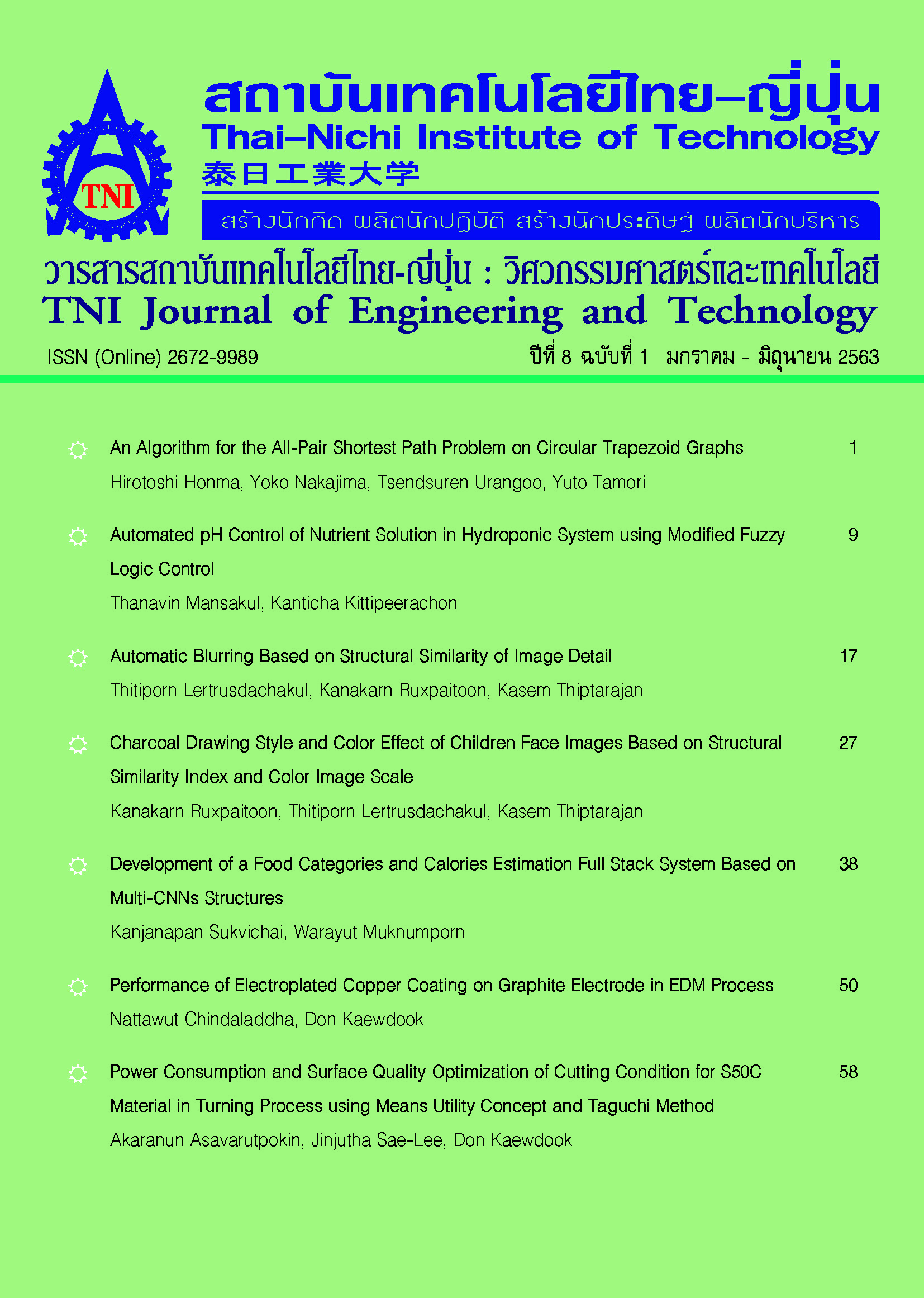Study on The Color Feature of Harajuku-type Kawaii Fashion Comparison with Street Snap Images Using Colorfulness
Main Article Content
Abstract
This research focuses on Harajuku-type Kawaii fashion style. Based on the fashion experience of the second author, we made the hypothesis that Harajuku-type Kawaii fashion contains high saturation and a large variety of color. In this work, we objectively tested these hypotheses by preparing original data sets of 3 styles: Harajuku-type Kawaii fashion, Harajuku Street snaps, and Shibuya Street snaps. We calculate saturation and employ colorfulness to quantify the variety of colors. The data sets were selected and properly modified based on heuristic rules according to the fashion experience so that each data set contains only images with typical features of its style. From the data analysis, we found that the saturation and colorfulness of Harajuku-type Kawaii fashion is statistically higher than the other two data sets. As a result, we successfully verified that Harajuku-type Kawaii fashion is very distinct in its saturation and colorfulness with statistical evidence.
Article Details
Article Accepting Policy
The editorial board of Thai-Nichi Institute of Technology is pleased to receive articles from lecturers and experts in the fields of engineering and technology written in Thai or English. The academic work submitted for publication must not be published in any other publication before and must not be under consideration of other journal submissions. Therefore, those interested in participating in the dissemination of work and knowledge can submit their article to the editorial board for further submission to the screening committee to consider publishing in the journal. The articles that can be published include solely research articles. Interested persons can prepare their articles by reviewing recommendations for article authors.
Copyright infringement is solely the responsibility of the author(s) of the article. Articles that have been published must be screened and reviewed for quality from qualified experts approved by the editorial board.
The text that appears within each article published in this research journal is a personal opinion of each author, nothing related to Thai-Nichi Institute of Technology, and other faculty members in the institution in any way. Responsibilities and accuracy for the content of each article are owned by each author. If there is any mistake, each author will be responsible for his/her own article(s).
The editorial board reserves the right not to bring any content, views or comments of articles in the Journal of Thai-Nichi Institute of Technology to publish before receiving permission from the authorized author(s) in writing. The published work is the copyright of the Journal of Thai-Nichi Institute of Technology.
References
S. Ngai, Our aesthetic categories: Zany, cute, interesting. Cambridge, MA, USA: Harvard University Press, 2012.
A. D. Cheok, “Kawaii/Cute interactive media,” in Art and Technology of Entertainment Computing and Communication: Advances in Interactive New Media for Entertainment Computing, London, U.K.: Springer London, 2010, ch.9, pp. 223-254.
M. Ohkura, T. Komatsu, and T. Aoto, “Kawaii rules: Increasing affective value of industrial products,” in Industrial Applications of Affective Engineering, Switzerland: Springer Cham, 2014, pp. 97-110.
K. Miyatake, “Japanese Kawaii fashion–historic changes in trends and styles,” (in Japanese), presented at the Proc. 13th Spring Conf. of Japan Society of Kansei Engineering, Nagoya, Japan, Mar. 2018.
M. Sebastian. “Matsuda Sebastian's Official Website.” M-SEBAS.ASOBISYSTEM.com. http://m-sebas.asobisystem.com (accessed Mar 28, 2020).
S. Waka. “Kyary Pamyu Pamyu.” WAKAPEDIA.it. http://www.wakapedia.it/en/kyary-pamyu-pamyu/ (accessed Mar 28, 2020).
Nippon. “Kyary Pamyu Pamyu’s J-Pop “Kawaii” in Paris,” NIPPON.com. https://www.nippon.com/en/views/b00113/kyary-pamyu-pamyu’s-j-pop-kawaii-in-paris.html (accessed Mar 28, 2020).
P. S. Michel. “How J-Pop stars gain from the west's obsession with 'Weird' Japan.” THEATLANTIC.com. https://www.theatlantic.com/entertainment/archive/2012/06/how-j-pop-stars-gain-from-the-wests-obsession-with-weird-japan/258565/ (accessed Mar 28, 2020).
Itsweb. “International Talent Support.” ITSWEB.org. https://www.itsweb.org/jsp/en/about/index.jsp (accessed Mar 28, 2020).
Kobefashion. “Kobe Fashion Contest.” KOBEFASHION.jp. http://kobefashion.jp/about/ (accessed Mar 28, 2020).
S. Takamasa, The revolution of Kawaii worldwide, Japan: PHP SHINSHO (in Japanese), 2009.
M. Yahata, and A. Watanabe, “The roots of Lolita fashion - focus on street fashion after the 1980s,” (in Japanese), Annual Bulletin of Department of the Science and Living, vol. 56, pp. 11-31, 2013.
K. Miyatake, P. Sripian, and M. Ohkura, “Study on style of Harajuku kawaii fashion (1st Report) - Design Features,” (in Japanese), presented at the 20th Annual Meeting of Japan Society of Kansei Engineering, Tokyo, Japan, Sep. 4-6, 2018.
P. Sripian, K. Miyatake, and M. Ohkura, “Study on style of Harajuku kawaii fashion (2nd Report). color features,” presented at the 20th Annual Meeting of Japan Society of Kansei Engineering, Tokyo, Japan, Sep 4-6, 2018.
D. Hasler, and S. E. Suesstrunk, “Measuring colorfulness in natural images,” in Proc. Vol. 5007, Human vision and electronic imaging VIII, Santa Clara, CA, USA, Jun. 2003, pp. 87-96.
A. Medda and V. DeBrunner, "Color image quality index based on the UIQI," in Proc. IEEE Southwest Symposium on Image Analysis and Interpretation, Denver, CO, USA, Mar. 2006, pp. 213-217, doi: 10.1109/SSIAI.2006.1633753.
T. Y. Park, K. W. Ko, and Y. H. Ha, “Analysis of relationship between image compression and Gamut variation: JPEG and JPEG2000,” Journal of Imaging Science on Technology, vol. 53, no. 6, pp. 60402-1-60402-12, Nov. 2009, doi:10.2352/J.ImagingSci.Technol.2009.53.6.060402.
M. Frackiewicz, and H. Palus, “New image quality metric used for the assessment of color quantization algorithms,” in Proc. Vol. 10341, Ninth International Conference on Machine Vision (ICMV 2016), Nice, France, 2017, pp. 1-5.
Z. Jiang, S. Y. Nagasawa, and J. Watada, “Luxury fashion brand image building: The role of store design in Bally and Tod's Japan,” Management Decision, vol. 52, no. 7, pp. 1288-1301, 2014.
M. Chevalier and G. Mazzalovo, Luxury brand management: A world of privilege, NJ, USA: John Wiley & Sons, 2012.


